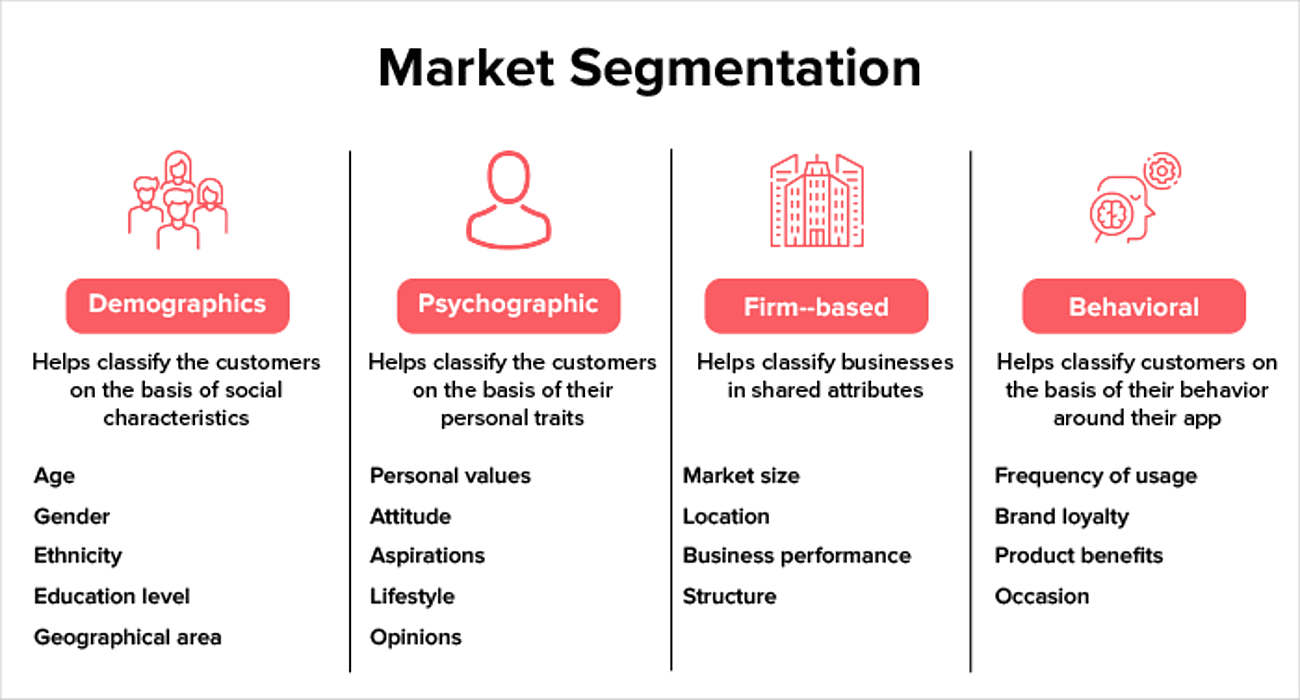
What if we told you that Amazon and Netflix as you know wouldn’t have been the same if their founders hadn’t run a thorough target market analysis? Sounds difficult to believe, doesn’t it? However, the former would have remained a bookstore while the latter would have been a successful DVD store (till the technology was in demand) had they not focused on target market analysis.
Knowing how to identify your target market can help you understand if the app is right for your business, build market segmentation, and get you to your target audience in time. Now while market segmentation according to the target market sounds easy, it is probably the biggest contributor to failed businesses. Thus, having an answer to how to define your target market becomes critical to your business’s success.
In this article today, we are going to dive into the reply to ‘what’s your target market’ by looking at elements like -
- Defining the target market
- The types of the target market
- How to run an analysis of your target market
Defining the target market
Target market strategy revolves around establishing a group of people you will be reaching out to with the marketing message. These are the people who are likely to spend their money on your app and are united by some common traits like behaviors and demographics.
Until and unless you are Google, the chances that the world is your audience is very slim. And thus, you will need a proper target market segmentation plan to reach the right audience. A key part of answering how you would describe your target market lies in understanding the difference between the two common interchangeable words: target audience and target marketing.
The target market is typically the end customer while the target audience is the one your brand advertises to. An example of a target market can be seen in a coaching institute. While the target market of the institute will be the students, the decision maker or the people paying for the service are the parents - who are also the target audience.
A key part of defining the target market strategy lies in knowing the types of the target market. Let us look into the concept in detail in the next section.
Types of target market segmentation
Target market segmentation is an approach where the market gets divided into small groups of people in order to identify the scope of growth. Additionally, the answer to how you can identify your target market also lies in understanding the different types of target market analysis.

1. Demographic market segmentation
This mode of defining the target market classifies the customers on the basis of attributes like location, income level, and age. This typically comes in handy during B2C marketing efforts. The elements to note here are:
- Gender
- Age
- Ethnicity
- Income
- Education level
- Geographical area
2. Psychographic market segmentation
This part of the market segmentation answers what's your target market is by classifying customers on the basis of their personal traits like attitudes and values. Usually, the factors that are considered under this segment includes:
- Personal values
- Political Stance
- Attitude
- Aspirations
- Lifestyle
- Opinions
3. Firm-based market segmentation
This type of target audience analysis classifies businesses in shared attributes like the number of employees and industry type. The common elements in this market segmentation include -
- Market size
- Location
- Business performance
- Structure
4. Behavioral market segmentation
This classifies customers on the basis of their behavior around your app - when do they buy your product and how do they intend to use it? Here are some of the elements that help design the behavioral market segmentation -
- Frequency of usage
- Brand loyalty
- Product benefits
- Occasion
So here were the different types of target market segmentation that help answer how to reach your target audience in a strategic manner. With the types of target audience addressed, the next crucial element is to plan out the defining of the target market stage. Let us get to that next.
How can you identify your target market?
The answer to how to identify your target market is not as straightforward as founders would like it to be. There is extensive research involved in finding and then targeting your potential customers with the best marketing strategies.
However, there are some time-tested ways to run target audience analysis, ones that we are going to look into.
1. Gather the customer data
The primary step of target marketing lies in defining your existing or past customers. Try to identify shared attributes or buying patterns through web analytics tools, email campaigns, and social media. Here are the factors you should be on the lookout for -
- Age
- Location
- What made them buy your product
- The marketing campaign that helped them convert
- Psychological attributes
It is critical to make this information tracking a constant effort as it will help keep the findings organized and make it easy to find new trends or patterns shaping up. The details you gather here will play a crucial role in deciding your app marketing efforts later.
2. Get to know your products
Another part of the answer to how you would describe your target market lies in getting to know your products. Spend some time with the existing and past buyers to understand what made them buy the app and the impact it created. When doing this study, it helps to go beyond the app features and look into the benefits it offers the customers on a day-on-day end.
Knowing in what situations customers choose your brand and how they use it thereafter will help you chart out a strategic, data-driven target market strategy. The different ways to gather this data can be to send your customer surveys, get your product reviewed, schedule a call, or simply give them a reward in return for their time in both emails and calls.
3. Analyze your competitors
Another approach to the question ‘how can you identify your target market’ can be to dive into your competitors. Investigate their portfolio through websites, blogs, and social media posts and try to identify a pattern through the content in terms of who they are targeting as the audience. You should also look into the comments on the posts to analyze the kind of people interacting with their business.
All of this will help you understand the problem customers are looking to solve through your competitors (by looking into the list of high-performing content pieces) and the areas you will have to work on to get this audience’s attention.
4. Draft a target market segmentation statement
Up until this point, you would have a high-level answer to how to identify your target customers. It's time to put those findings on paper. This activity will help you put your findings into perspective as you plan your marketing efforts around them. Here are the things that should be made a part of the target market segmentation statement -
- Demographic information
- Key interest and pain points of your target market
- Things that will motivate them to make the purchase.
The statement will keep your marketing and branding activities consistent in terms of messaging that you adopt and the expected audience.
5. Refine the research
Running an analysis of your target market is going to be a continuous research-backed task. Even when you identify the types of target audience, you will need to run experiments on keeping it up to date with the changing marketing needs.
An approach to achieve this can be to keep on top of your existing customers - analyze why they are buying from you, what their opinion is on your offering, and the benefits they are drawing from it. This will help you measure the efficiency of your app marketing communication and run well-strategized A/B testing on the product by partnering with the top mobile app development companies.
With this, we have answered the most critical question of how to define your target market. The important thing to note here is to treat it as a continuous task and not as a one-time effort. With the competition growing in the mobile app space, the chances of people using your app to serve the same intent even after two years are very slim, meaning you will have to constantly pivot keeping the changing target marketing in mind.
We hope that you now know the way to how to reach your target audience with complete confidence (at least in one part). The other part of it lies in knowing the best marketing strategies that you will apply after running a target audience analysis.
The best marketing strategies
Once you know what’s your target market is, the next part lies in understanding what to do with this information - how to fit it into your marketing efforts.
- Mass marketing - This is the targeting strategy where you let go of the market segmentation and advertise to the masses. It works great for app businesses like games, financial planning, etc.
- Differentiated marketing - This is where businesses build different marketing campaigns according to different target audience analysis. Through this, they are able to identify their value proposition for different classes of buyers.
- Niche marketing - Also known as concentrated marketing, here all the marketing efforts are highly concentrated on a specific audience whose needs are not met by any other brand. This strategy works best for businesses that are entering a currently unserviceable market.
A casual search for an example of a target market will come back with results like Nike founder Phil Knight saying, “Ultimately, we determined that we wanted Nike to be the world’s best sports and fitness company and the Nike brand to represent sports and fitness activities. Once you say that, you have focus.” or Takasa founders Kuljit and Ruby mentioning, “Our target market is the LOHAS segment, which means Family Lifestyles of Health and Sustainability. This group of people is already living, or striving to live, a green lifestyle … We know our target demo is very conscious about what their families consume, as well as the impact this consumption has on the environment.”
Defining the target market for your application or physical product will be an effort that combines both internal and external research. However, knowing how companies define their target marketing statement can help set you on the right path in terms of what yours should contain.
We hope that the article helped answer how to define your target market and that you will now be on the path to elevating your marketing efforts with a new approach.
















